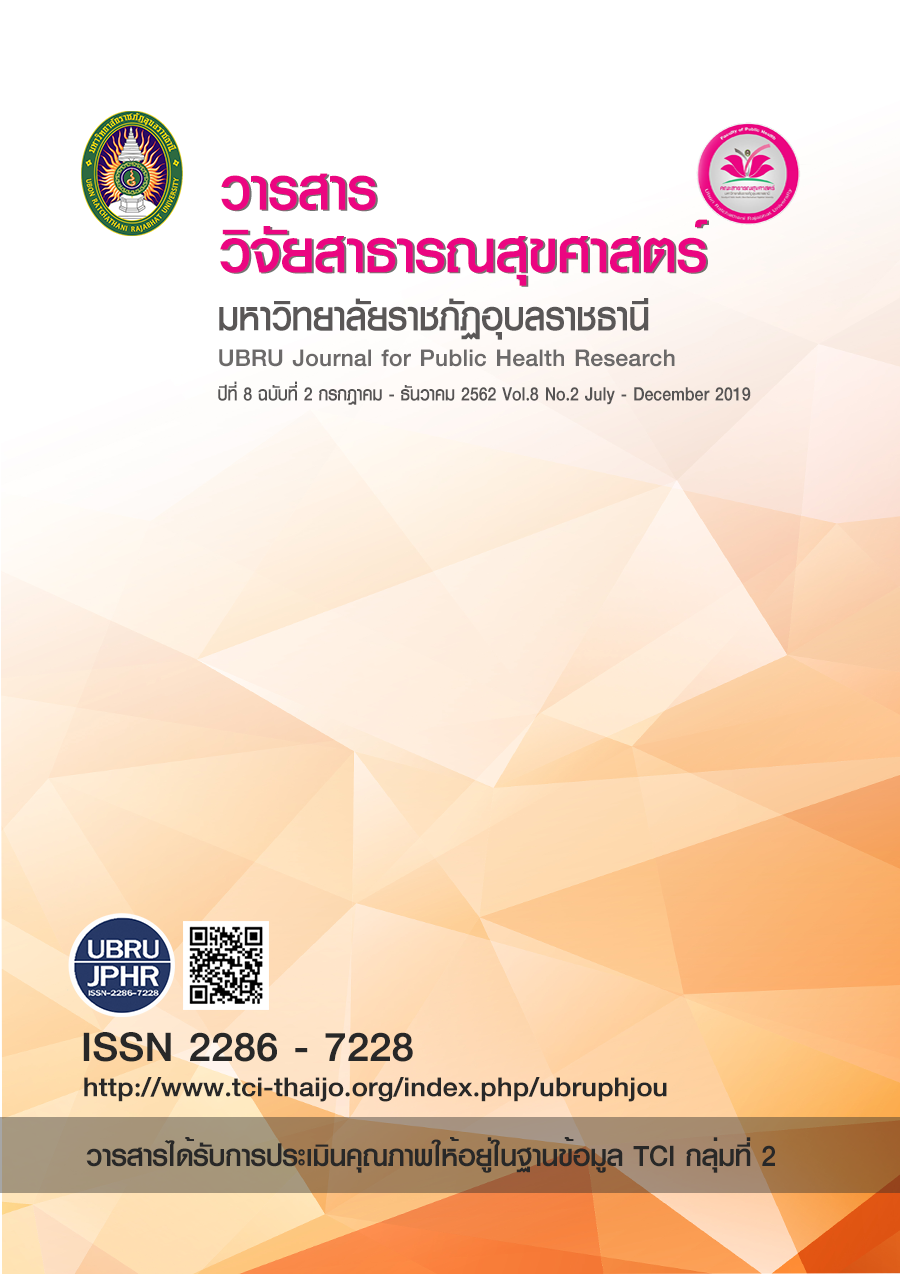Perceived benefits and perceived barriers of having safe practices and healthy lifestyles to prevent epidemic diseases among people living in the border areas of Ubon Ratchathani Province
Keywords:
Communicable diseases, perceived benefits, perceived barriers, border areas, Ubon Ratchathani ProvinceAbstract
This study aimed to survey attitudes towards perceived benefits and perceived barriers of having safe practices and healthy lifestyles to prevent epidemic diseases among people living in the border areas of Ubon Ratchathani Province. This study was a cross-sectional descriptive study. It investigated two sample groups: patients who were sick with communicable diseases and people who were at risk of getting infected from communicable diseases. The two sample groups included Thais and foreigners who received hospital services in the border areas of Ubon Ratchathani Province between 2012 - 2013. Equipped with the two sample groups, seven hospitals in Ubon Ratchathani were examined. They were Khammaraj, Phochai, Srimuangmai, Khongjam, Sirinthorn, Boontarik, and Najaroy hospitals. The survey forms were created and distributed to two sample groups in seven hospitals. The collected data were analyzed by using descriptive statistics, that is percentage and frequency distribution. The results found that most of the samples had their attitudes towards perceived benefits and perceived barriers of preventing epidemic diseases at a moderate level (49.2%). In addition, the majority attitudes agreed with wearing a mask at all times to help protect from being infected from the airborne diseases in crowded places. Moreover, the sample groups accepted the idea that following the news about epidemic diseases continuously would help them to be aware of preventing themselves from being infected by communicable diseases (83.5 % and 72.0 %, respectively). Although most subjects perceived the benefits and barriers of practicing themselves to prevent epidemic diseases at a moderate level, some subjects were still found to be at a lower level. Interestingly, the practices of most people for preventing epidemic diseases were in a moderate level. The results were relevant to the social cognitive theory which is the basis of the Health Belief Model. The model states that if a person has good knowledge and perception in some certain cases, the good knowledge and the fine perception will affect his behaviors or actions to do well in those cases.
References
Bandura, A. (1977). Social Learning Theory. N.J.: Prentice Hall.
Becker, M. H. (1974). “The Health Belief Model and Personal Health Behavior,” Health Education Monographs. 21(3), 351-63.
Chirawatkul, A. (2004). Biostatistics for Health Science Research. Faculty of public health, Khon Kaen University.
Chugh, S. (2008). Paediatric tuberculosis and DOTS strategy under RNTCP. J Indian Med Assoc.106, 799-802.
Koktatong, K. and Koktatong, U. (2013). Development of AIDS self-prevention model in teenage. Journal of the office of DPC 6 Khon Kaen. 1, 31-41.
Lolekha, R., Anuwatnonthakate, A., Nateniyom, S. et al. (2008). Childhood TB epidemiology and treatment outcomes in Thailand: a TB active surveillance Network, 2004 to 2006. BMC Infect Dis.18(8), 94.
National AIDS Prevention and Alleviation Committee. (2010). UNGASS Country Progress Report Thailand: January 2008-December 2009. Bangkok: National AIDS Prevention and Alleviation Committee.
Nelson, L.J, and Wells, C.D. (2004). Global epidemiology of Childhood tuberculosis. Int J Tuberc Lung Dis. 8, 636-647.
Oberhelman, R.A., Soto-Castellares, G., Gilman, R.H., Caviedes, L, Castillo, M.E., Kolevic, L., Del Pino,T., Saito, M., Salazar-Lindo, E., Negron, E., Montenegro, S., Laguna-Torres, VA., Moore, DA., Evans, CA. (2010). Diagnostic approaches for paediatric tuberculosis by use of different specimen types, culture methods, and PCR: a prospective case-control study. Lancet Infect Dis.10, 581-2.
Rosenstock, I. M. (1974). Historical Origins of the Health Belief Model. Health Education Monographs. 2, 328-333.
Rosenstock, I. M., Strecher, V.J., and Becker, M.H. (1988). “Social Learning Theory and the Health Belief Model. Health Education Quarterly. 15(2), 175-183.
Downloads
Published
How to Cite
Issue
Section
License
เนื้อหาและข้อมูลในบทความที่ลงตีพิมพ์ในวารสารวารสารวิจัยสาธารณสุขศาสตร์ มหาวิทยาลัยราชภัฏอุบลราชธานี ถือเป็นข้อคิดเห็นและความรับผิดชอบของผู้เขียนบทความโดยตรงซึ่งกองบรรณาธิการวารสาร ไม่จำเป็นต้องเห็นด้วย หรือร่วมรับผิดชอบใดๆ
บทความ ข้อมูล เนื้อหา รูปภาพ ฯลฯ ที่ได้รับการตีพิมพ์ในวารสารนี้ ถือเป็นลิขสิทธิ์ของวารสารฯ หากบุคคลหรือหน่วยงานใดต้องการนำทั้งหมดหรือส่วนหนึ่งส่วนใดไปเผยแพร่ต่อหรือเพื่อกระทำการใดๆ จะต้องได้รับอนุญาตเป็นลายลักอักษรณ์จากบรรณาธิการวารสารนี้ก่อนเท่านั้น

